|
The first .38 Special revolver
Swing out cylinder, solid frame, double action
revolvers were well established by the last decade of the 19th century.
Iver
Johnson employed the concept as early as 1879 and Colt’s
Models of 1889-90, chambered for the .38 Long Colt cartridge
were the standard U.S. Military sidearm by the early 1890s. Smith
and Wesson called their version a “ Hand Ejector” to
differentiate if from the break –top, automatic ejection arms
of the time. In 1899, the Army and Navy placed orders with Smith
and Wesson for two to three thousand (sources vary as to the
exact number) Hand Ejector revolvers chambered for the .38 U.S.
Service Cartridge (Long Colt.). It became the Military and
Police model of 1899. The need for these additional revolvers
arose during the Spanish- American War.
These revolvers, along with the very similar Colts were
in service during the Philippine insurrection of 1899. Early
sources universally report that the old Long Colt cartridge was
considered inadequate against the Moro warriors encountered
there. Smith
and Wesson responded by lengthening the .38 case and increasing
the powder charge and bullet weight.
Nominal velocity of the new .38 S&W Special cartridge
was 870 feet per second against the reported 780 fps of the
earlier round. Bullet
weight increased from 150 to 158 grains and the black powder
charge upped from 18 to 21 grains.
It is clear that the military contract revolvers
chambered the .38 Long Colt round.
Early references indicate that the .38 Specials might
have gone to the civilian market.
Serial number run from number 1 in the K Frame Military
and Police series to 20,975 spanning the years 1899- 1902.
At a glance, the model of 1899 appears nearly
identical to the quintessential M&P of the 20th
century. The
primary visible difference is the absence of a front locking
lug. The cylinder
locks only at the rear and at the locking notches leaving the
ejector free standing. Barrel
lengths are four, five, six and six and a half inches with
finish options of blue and nickel. There are also target-sighted
versions. These and serial number blocks-associated with small
military orders, are very desirable as collectors items.
First Model M&P revolvers often exhibit the
extremes of neglect. Black powder, chlorate priming and owner
indifference take their toll among many examples. They do not
fare nearly as well as the hand ejectors of 1902 and later.
Mine, number 8200, has only minor finish blemishes
and is in near-new mechanical condition. The cylinder and crane
lock tightly into the frame and timing is perfect. The bore and
chambers are pristine and the internal lockwork - once relieved
of decades of congealed lubricant - might well have been forged
last week instead of 103 years ago. According to the factory
letter, the revolver went to Bekeart & Company of San
Francisco CA on December 20, 1900. Additional provenance shows
the M&P registered to an E6 at Wheeler AFB, Hawaii
in 1975 and has remained in his possession until this year.
Shooting the first .38 Special revolver
While the early Smith and Wessons resemble the Colt
double actions in function and broad outline, I have always
found the handling characteristics and the action of the Smiths
to be much more desirable.
This is purely a personal opinion and the gun magazines
used to rage over the question “ Which is Better? Colt or
Smith and Wesson.” M&P
# 8200 with its frame fitting round butt and six- inch barrel
points very well. The sight picture, comprised of a knife-sharp
front blade and a tiny rear notch proved to be the limiting
factor in shooting precise groups. On the other hand, the four
pound single action trigger and the typically smooth Smith and
Wesson Double Action, were great aides to practical accuracy. Many service revolvers and autos of the 19th and
early 20th centuries feature raunchy six- pound
single action triggers making it very hard to achieve any degree
of precision.
M&P cylinders were not heat treated until 1920 so
standard; factory level pressures are the order of the day.
My standard .38 Special load is 3.5 grains of Alliant
Bullseye and the available 158- grain Lead bullet.
This is a few tenths grain under the listed factory
duplicate and the tightly gapped Model 1899 averaged 859 fps
with the swaged Hornady SWC and 862 with a five round
string of machine cast 158 SWC. This and subsequent shooting was
done in five shot strings.
The First M&P has no provision for a hammer block
safety and while earlier owners no doubt loaded all six chambers
with impunity, hindsight demands that we leave an empty under
the hammer.
In keeping with shooting practices at the end of the
19th Century, I did most of my shooting one-handed.
This is how Walter Mitty’s dad would have done
it and it captures the flavor of the era.
My 25 yard bench groups and fifty foot off hand efforts
ran four inches. I
was unable to fully exploit the accuracy of the revolver because
of the sight picture. Point of impact was dead on for elevation
and slightly to left of point of aim.
The light recoil of the standard .38 Special and the
superior handling qualities of the Smith Hand Ejector came into
their own in the more “practical” shooting exercises. Firing
double action single-handed with the shots spaced about one
second apart, I was able to keep fifteen consecutive rounds in
the center ring of the Texas Police Target at twenty-five
yards.. The sights did not seem much of a handicap in this
application. The revolver came very naturally up to point. A
clear flash sight picture came about naturally and hung steady
through the smooth double action pull. I also managed ten
consecutive hits on the upper torso from a vertical braced
position single action at fifty yards.
The Military and Police first model emerged as a
dynamic reactive tool for the gunfighter of a century ago.
It continues to satisfy the essential criteria for a
personal sidearm in the present day.
Mike
Cumpston
  
Got something to say about this article? Want to agree (or
disagree) with it? Click the following link to go to the GUNBlast Feedback Page.
|
|
Click pictures for a larger version.

This .38 Special Model 1899 Military and
Police Hand Ejector left the factory on December 20, 1900.
In 1900, the population of the United
States reached 81,000,000. There were 144 miles of paved roads
and 13,800 automobiles. William McKinley was president and
Carry Nation was chopping up saloons with her ax. Buffalo Bill
incorporated Cody Wyoming.
One in thirteen American homes had a telephone while
one in seven had a bathtub.
The average age at death was 47.
It was the last year of the Victorian Era
and the last year of the 19th Century.
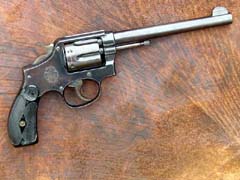
This is the original .38 Special. In the days when the horse and buggy was the dominant means
of transportation and Oklahoma, New Mexico and Arizona were
still western territories, it was a dynamic gunfighter’s
tool.
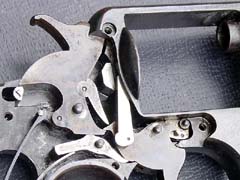
The trigger return spring is a flat leaf
separate from the mainspring.
The cylinder crane attaches to the frame by way of a
spring loaded plunger rather than the screw used in later
designs. It has
been called a “pre five screw four screw” by collectors.

In an age of tiny revolver sights, the
M&P may well take the prize for the near absent sight
picture.
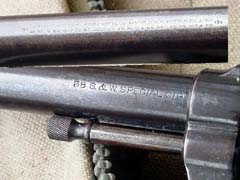
Patent dates range from 1884 to 1898.
Smith and Wesson brought out their first Hand Ejector
Revolver in 1896 chambered for the new .32 S&W Long
cartridge.
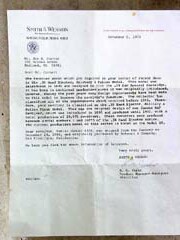
From Roy Jinks 1975.
The revolver was shipped to the Phillip Bekeart Company
in San Francisco. Bekeart
was an early Smith and Wesson enthusiast.
In 1911, at his behest, S&W the company introduced
the Bekeart Target revolver.
This revolver became the basis for the famous 22-32 Kit
Gun.
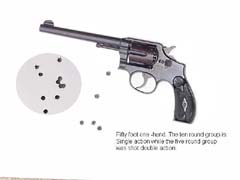
The 6” barrel, round butt M&P with
its smooth action is a fine shooter. The limiting factor is
the shooter’s ability to see the extremely small sights.
They serve very well in good light and in applications where
precision target accuracy is not the primary goal.
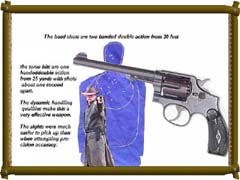
The practical value of the first M&P is
demonstrated at 30 feet and 25 yards.
|
![]()